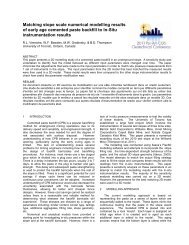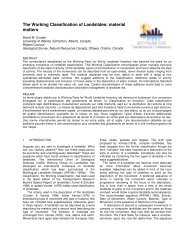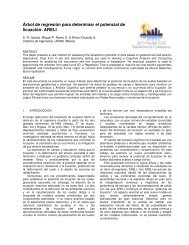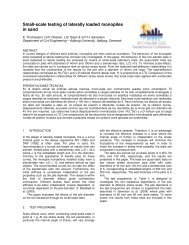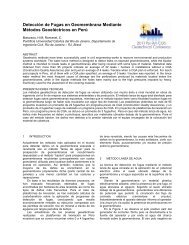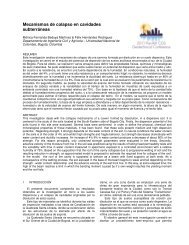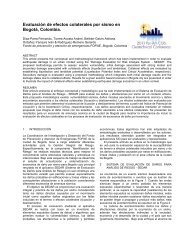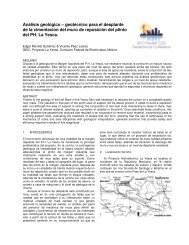MS Word Technical Paper Template
MS Word Technical Paper Template
MS Word Technical Paper Template
Create successful ePaper yourself
Turn your PDF publications into a flip-book with our unique Google optimized e-Paper software.
Figure 4: Dependence of cyclic simple shear resistance on relative density at different OCR values<br />
specimens consolidated to a relative density of D r = 41%<br />
and a confining stress level of 200 kPa at two cyclic stress<br />
ratio values. This illustrates the exponential increase in<br />
the number of cycles to liquefaction as OCR increases.<br />
Same data is plotted as a ratio of the number of cycles to<br />
liquefaction in overconsolidated soils to that in normally<br />
consolidated soils, termed K OCN in Figure 5(b). The rate<br />
of increase in K OCN is higher at lower CSR = 0.15<br />
compared to CSR = 0.26 indicating that much stronger<br />
response compared to that of normally consolidated<br />
sands can be expected from overconsolidated soils under<br />
small levels of shaking.<br />
4.2 Cyclic resistance ratio, CRR<br />
The cyclic resistance ratio, CRR was derived from the<br />
experimental database for normally consolidated and<br />
overconsolidated sands at 100, 200 and 400 kPa effective<br />
confining stress levels at select density states. Figure 6<br />
shows the variation of CRR with density at two OCR<br />
levels over a range of confining stress levels. Decreasing<br />
cyclic resistance with increasing confining stress level can<br />
be noted in both normally consolidated and over<br />
consolidated sands. This reduction in cyclic resistance at<br />
a given density with increasing confining stresses has<br />
been attributed to the increased contractive tendency (or<br />
reduced dilative tendency) at the higher confining stress in<br />
the literature (Vaid et al. 1985; Vaid & Chern 1985). It is<br />
consistent with the observed strain softening tendencies<br />
under monotonic loading at higher confining stress levels<br />
(Vaid and Sivathayalan, 2000). The results presented<br />
herein clearly indicate that even small levels of<br />
overconsolidation can significantly increase the cyclic<br />
resistance of sands. Current design practice does not<br />
typically account for this strength gain, and could lead to<br />
extremely conservatism even in lightly to moderately<br />
overconsolidated soils.<br />
A direct comparison of the influence of OCR on the<br />
cyclic resistance ratio is made in Figure 7. It shows the<br />
variation of the K OCR factor with the overconsolidation ratio<br />
at different confining stress levels. K OCR factor is defined<br />
Figure 5: Effect of OCR on Number of cycles to liquefaction




